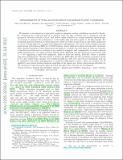| dc.contributor.author | Hirano, Teruyuki | |
| dc.contributor.author | Sanchis Ojeda, Roberto | |
| dc.contributor.author | Takeda, Yoichi | |
| dc.contributor.author | Narita, Norio | |
| dc.contributor.author | Winn, Joshua Nathan | |
| dc.contributor.author | Taruya, Atsushi | |
| dc.contributor.author | Suto, Yasushi | |
| dc.date.accessioned | 2013-02-05T21:01:28Z | |
| dc.date.available | 2013-02-05T21:01:28Z | |
| dc.date.issued | 2012-08 | |
| dc.date.submitted | 2012-04 | |
| dc.identifier.issn | 0004-637X | |
| dc.identifier.issn | 1538-4357 | |
| dc.identifier.uri | http://hdl.handle.net/1721.1/76737 | |
| dc.description.abstract | We present an investigation of spin-orbit angles for planetary system candidates reported by Kepler. By combining the rotational period P[subscript s] inferred from the flux variation due to starspots and the projected rotational velocity Vsin I[subscript s] and stellar radius obtained by a high-resolution spectroscopy, we attempt to estimate the inclination I[subscript s] of the stellar spin axis with respect to the line of sight. For transiting planetary systems, in which planetary orbits are edge-on seen from us, the stellar inclination I[subscript s] can be a useful indicator of a spin-orbit alignment/misalignment. We newly conducted spectroscopic observations with Subaru/HDS for 15 Kepler Object of Interest (KOI) systems, whose light curves show periodic flux variations. Detailed analyses of their light curves and spectra revealed that some of them are binaries, or the flux variations are too coherent to be caused by starspots, and consequently we could constrain stellar inclinations I[subscript s] for eight systems. Among them, KOI-262 and 280 are in good agreement with I[subscript s] = 90° suggesting a spin-orbit alignment, while at least one system, KOI-261, shows a possible spin-orbit misalignment. We also obtain a small I[subscript s] for KOI-1463, but the transiting companion seems to be a star rather than a planet. The results for KOI-257, 269, 367, and 974 are ambiguous and can be explained with either misalignments or moderate differential rotation. Since our method can be applied to any system having starspots regardless of the planet size, future observations will allow for the expansion of the parameter space in which the spin-orbit relations are investigated. | en_US |
| dc.description.sponsorship | United States. National Aeronautics and Space Administration (NNX11AG85G) | en_US |
| dc.language.iso | en_US | |
| dc.publisher | IOP Publishing | en_US |
| dc.relation.isversionof | http://dx.doi.org/10.1088/0004-637x/756/1/66 | en_US |
| dc.rights | Creative Commons Attribution-Noncommercial-Share Alike 3.0 | en_US |
| dc.rights.uri | http://creativecommons.org/licenses/by-nc-sa/3.0/ | en_US |
| dc.source | arXiv | en_US |
| dc.title | Measurements of stellar inclinations for kepler planet candidates | en_US |
| dc.type | Article | en_US |
| dc.identifier.citation | Hirano, Teruyuki et al. “Measurements of stellar inclinations for kepler planet candidates.” The Astrophysical Journal 756.1 (2012): 66. | en_US |
| dc.contributor.department | Massachusetts Institute of Technology. Department of Physics | en_US |
| dc.contributor.department | MIT Kavli Institute for Astrophysics and Space Research | en_US |
| dc.contributor.mitauthor | Sanchis Ojeda, Roberto | |
| dc.contributor.mitauthor | Winn, Joshua Nathan | |
| dc.relation.journal | Astrophysical Journal | en_US |
| dc.eprint.version | Author's final manuscript | en_US |
| dc.type.uri | http://purl.org/eprint/type/JournalArticle | en_US |
| eprint.status | http://purl.org/eprint/status/PeerReviewed | en_US |
| dspace.orderedauthors | Hirano, Teruyuki; Sanchis-Ojeda, Roberto; Takeda, Yoichi; Narita, Norio; Winn, Joshua N.; Taruya, Atsushi; Suto, Yasushi | en |
| dc.identifier.orcid | https://orcid.org/0000-0002-4265-047X | |
| mit.license | OPEN_ACCESS_POLICY | en_US |
| mit.metadata.status | Complete | |
